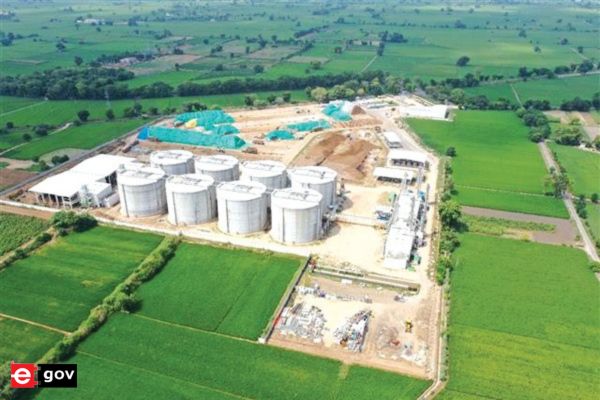
By reducing carbon emissions and promoting circular economy practices, Asia’s largest Compressed Bio Gas plant in Sangrur, Punjab utilises cutting-edge technology and strict quality control measures to deliver high-quality CBG, making it a preferred choice for industries and households alike.
The establishment of Asia’s largest Compressed BioGas (CBG) plant in Sangrur, Punjab holds significant importance on various fronts. The CBG Plant at Sangrur, is spread across an area of 20 acres (approx.). The plant’s present production is about 6 TPD CBG, but soon this plant will process 300 Tons Per Day of paddy straw at max. capacity to produce 33 TPD of CBG using 8 digesters of 10,000 cubic meters. This state-of-the-art facility represents a major milestone in the renewable energy sector, fostering sustainable development and contributing to multiple aspects of socio-economic progress.
The benefits of the Sangrur CBG plant for rural economy stems from the fact that this plant will consume 100,000 tons of paddy straw, which will be procured from 6-8 satellite locations within a 10 km radius of the plant. There shall be daily production of about 600-650 Tons of FOM (Fermented Organic Manure), which can be used for organic farming. The CBG Plant shall also provide direct employment to 390 and indirect employment to 585 people.

Not only will this plant generate additional income for Sangrur’s farmers, but it will also provide a much-needed alternative to stubble burning. The Plant will reduce stubble burning of 40,000 – 45,000 acres of fields, translating into an annual reduction of 150,000 tons of CO2 emissions, which will not only ensure that the citizens of Sangrur, Punjab, breathe in cleaner air but also contribute towards India’s COP26 Climate Change targets of total projected carbon emissions by one billion tonnes from now to 2030 Achieving the target of net zero emissions by 2070.
Here are some key reasons why the plant’s significance cannot be overstated:

- Renewable Energy Generation: The CBG plant harnesses the potential of organic waste and agricultural residue to produce clean and renewable energy. By employing advanced anaerobic digestion technology, it converts biodegradable waste into high- quality biogas, which can be utilized as a substitute for conventional fossil fuels. This renewable energy generation helps reduce greenhouse gas emissions and mitigates climate change impacts.
- Waste Management Solution: One of the pressing challenges faced by many regions, including Sangrur, is effective waste management. The CBG plant plays a crucial role in addressing this issue by providing a sustainable solution for organic waste disposal. By diverting agricultural residue, crop stubble, and other organic waste from landfills or burning, the plant helps prevent pollution, soil degradation, and health hazards associated with improper waste management practices.
- Rural Economy Boost: The establishment of Asia’s largest CBG plant brings immense economic benefits to the local community, particularly in rural areas. Farmers and rural entrepreneurs can actively participate in the supply chain by supplying agricultural waste and organic matter to the plant. This creates new income opportunities, enhances livelihoods, and promotes inclusive economic growth in the region. Moreover, the CBG plant generates employment through various stages, including waste collection, transportation, plant operations, and maintenance.
- Energy Access and Affordability: The CBG plant contributes to increasing energy access in the region, especially in rural areas where access to clean and affordable energy sources is limited. The biogas produced can be used for various purposes, such as cooking, heating, and power generation. This helps reduce dependence on traditional biomass fuels like firewood, crop residues, and cow dung, which are not only environmentally harmful but also pose health risks due to indoor air pollution. The availability of clean biogas improves living conditions, reduces energy expenses, and enhances the overall quality of life for the local population.
Also Read | Biomass offers huge potential, can help meet growing energy demand: MP Singh, Director, PEDA
- Sustainable Agriculture and Circular Economy: The CBG plant promotes sustainable agricultural practices by incentivizing the proper management of crop residues. Instead of burning or discarding them, farmers can sell these residues to the plant, creating an additional source of income. This practice encourages farmers to adopt alternative methods like mulching or incorporating crop residues back into the soil, leading to improved soil health, water retention, and nutrient recycling. Thus, the CBG plant contributes to the development of a circular economy model that optimizes resource utilization and minimizes waste.
- Government’s Renewable Energy Goals: The establishment of Asia’s largest CBG plant in Sangrur aligns with the government’s ambitious renewable energy targets. It showcases the commitment towards achieving a sustainable energy future and reducing reliance on fossil fuels. The plant’s large-scale operations and capacity contribute significantly to the renewable energy capacity of the region and support the government’s efforts to diversify the energy mix, enhance energy security, and meet climate change commitments.
Conclusion
In conclusion, Asia’s largest Compressed Bio Gas plant in Sangrur, Punjab, is of great importance due to its contributions to renewable energy generation, waste management, rural economy, energy access, sustainable agriculture, and the government’s renewable energy goals. The plant sets an inspiring example of how technological advancements and innovative solutions can drive sustainable development, benefitting both the environment and local communities.
Be a part of Elets Collaborative Initiatives. Join Us for Upcoming Events and explore business opportunities. Like us on Facebook , connect with us on LinkedIn and follow us on Twitter, Instagram.











